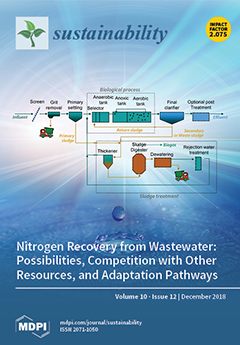In North China, row spacing is the most common planting pattern used for winter wheat. Currently, there are three sowing and tillage methods for row spacing: rotary tillage sowing with straw return (RTS), subsoil tillage sowing with straw return (DTS), and no-tillage sowing
[...] Read more.
In North China, row spacing is the most common planting pattern used for winter wheat. Currently, there are three sowing and tillage methods for row spacing: rotary tillage sowing with straw return (RTS), subsoil tillage sowing with straw return (DTS), and no-tillage sowing with straw return (NTS). Recently, Hao proposed a new sowing pattern called uniform broadcast sowing with straw return (BSS) which could increase winter wheat yield. In this research, a field experiment was conducted during the growing seasons in 2011–2012 and 2012–2013. The winter wheat (
Triticum aestivum L.) variety Jimai 22 was sowed with the four seeding and tillage methods—RTS, DTS, NTS, and BSS—at the China Agriculture University Wuqiao experimental station in the North China Plain. After tillage sowing and determining the sowing efficiency, the effective cover ratio of the seeds was measured, and the emergence ratio was calculated after emergence. In the two growing seasons, the growth and development stages were recorded. The dry matter accumulation (DMA), the yield, and the yield components (spikes per hectare, kernels per spike, and kernel weight) were also determined. We also measured the canopy structure leaf area index (LAI) and the stand uniformity. The results showed that BSS had the lowest emergence rate and lowest plant stands when compared with the other treatments. However, BSS had the highest grain yield at 7599.0 kg·ha
−1 and 9763.3 kg·ha
−1, which was 11.55, 16.17, 20.16% and 13.01, 15.68, 21.88% higher than DTS, RTS, and NTS in the 2011/2012 and 2012/2013 growing seasons, respectively. The improved grain yield of BSS was due to the increased productive tillers per hectometer-squared, which was attributed to the higher stand uniformity. More importantly, the increased tillers per hectare and grain yield were not accompanied by a reduction in grain number per spike or grain weight. The stand uniformity could facilitate canopy construction and population architecture and result in more even sunlight distribution, increased leaf area index (LAI) and sunlight interception, and enhanced photosynthetic activity. The stand uniformity also could increase both the pre-anthesis and post-anthesis DMA and promote the harvest index (HI). This study indicates that BSS is the most suitable sowing method for winter wheat production in North China.
Full article





